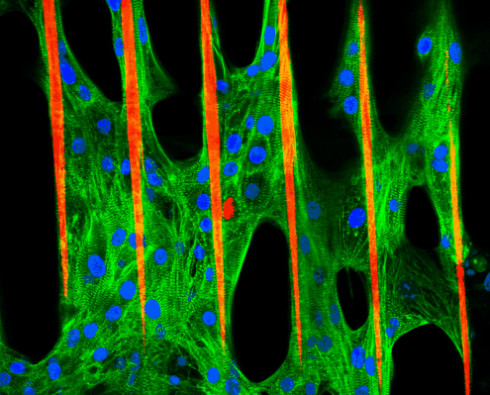Spotlight on: Bioengineering

The Biologist Vol 61(2) p40-41
Bioengineering applies the principles of engineering to problems involving biological material. It combines science, engineering, technology and medicine to create innovative devices, materials or processes for a diverse range of uses, but often related to improving human health.
Why is it important?
Bioengineering's most visible branch is the development of medical innovations such as prosthetics and high-tech implants, but genetic, stem cell and tissue engineering are all set to become key fields in the medicine of the future. Genetic engineering modifies the characteristics of an organism by manipulating its genetic material, while stem cell engineering and tissue engineering are the modification or repair of tissue using stem cells or biomaterials.
As well as healthcare applications, bioengineering exists to advance the study and application of any biological research into useful systems or tools. It has the power to translate biological knowledge into usable, economically viable products and practical, cost-effective solutions to 'real world' problems – from fuel and food production to environment and waste services.
What careers are available?
Some of the biggest employers of bioengineers are medical technology and imaging companies, such as Philips, GE and Siemens, and device and pharma companies such as Johnson & Johnson and GSK.
The NHS and hospitals also require bioengineers to help develop and improve medical devices, a specialty sometimes known as clinical engineering or medical physics. Bioengineers also work at the cellular and molecular level, with genetic engineering and nanotechnology an increasingly rich area of research and industrial applications.
Alongside bioengineers, computer scientists are required to design the electronic circuitry and software for lots of bioengineered tools. There are also numerous auxiliary careers in the design, sale and marketing of innovative, bioengineered products and services. Biomimetics, meanwhile, is a more niche field that uses the structure of living things as inspiration for the design of materials, buildings and machines.
How do I become a bioengineer?
Undergraduate and postgraduate bioengineering courses are relatively new, but lots of universities now
have bioengineering departments. While bioengineering degrees are widely available, many bioengineers begin their careers studying engineering, mechanics, physics or computer science before focusing their education and research on biological applications.
Where can I get more information?
- For jobs, news and social media networking for bioengineers, check out the International Society for Bioengineers. bioengineer.org
- The Engineering Council, the Royal Academy of Engineering and the Biomedical Engineering Society are among the biggest professional bodies for bioengineers in the UK.
www.engc.org.uk
www.raeng.org.uk
bmes.org
At a glance
 Name: Zhen Ma
Name: Zhen Ma
Profession: Postdoctoral associate, Healey Laboratory, University of California, Berkeley, US
Qualifications: PhD (bioengineering) Clemson University; MSc (bio-instrumentation) Tianjin University, China; BSc (engineering) Tianjin University, China
Interests: Stem cell biology and engineering, 'heart on a chip' technology, biomaterials
What does an average day in a tissue engineering lab involve?
I have to take care of my cells every day – it's like having a puppy. The first thing I do when I get here is to feed them. And cell culture medium is expensive food!
What is your lab working on?
Using stem cells, my colleagues create 'organ on a chip' microsystems to mimic different types of human tissue for drug screening and discovery. We can study how, for example, heart or liver microtissues react to drugs, and try to replace animal models. It's good to reduce the use of animals in research and drugs tested on animals still need to be tested on human tissue anyway.
I work specifically on heart cells: I create three-dimensional diseased cardiac tissue. Cells grow along a filamentous matrix of tiny fibres that mimics the way heart cells grow in vivo, where they align in one direction. The 3D structure makes it much more sensitive to the drug treatment than previous 2D systems.
What other interesting things are going on in the lab?
My colleagues are working on hydrogels, which are special biomaterials that can be injected into the heart to act like a sort of self-healing patch to encourage stem cells or tissue to regenerate. New cells grow on the heart to repair damaged tissue.
What do you enjoy about bioengineering?
Tissue engineering is really exciting and I really want to continue working in this field. It's so multi-disciplinary: we have chemists, computer scientists, engineers and biologists all working here.
Some of the other scientific projects are so big that you can't work by yourself; there's lots of sharing of expertise and collaboration. With my projects, I often sit with mechanical engineers to help work out how we can move forward. The matrix on which I grow the heart cells was fabricated by the engineering department, for example. The special fibres are just 5 microns (0.005mm) thick.
Have you found biology and engineering approaches differ?
The difference between biologists and engineers is that the biologist says 'how does this work?', while the engineer says 'OK, we know this works, so how can we make it better to work for us?'
It's interesting how people become bioengineers. My undergraduate degree was in electrical engineering, then I did a master's on instruments to detect glucose levels in blood, and then became more and more interested in bioengineering.
What excites you about bioengineering in the future?
The area I think is really hot right now is genomic engineering, where you change healthy cells to become diseased to study how those cells progress. Bringing that technology and stem cell and tissue engineering technology together could have a huge impact on human healthcare.


